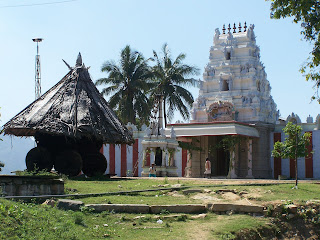PALAMALAI – RAMA IN EXILE
PALAMALAI – RAMA IN EXILE
This abode of Sri Ranganathar is located in Palamalai Hills near
Periyanaickenpalayam on Mettupalayam Highway (Ooty Road) about 30 kms from Coimbatore. Of late, this place is in news for man-animal conflict particularly with the ‘Rajahs’ (elephants – that’s how the locals address it) or ‘Doddavar’ (respectful reference to a family elder in Kannada). As everyone knows this is man made friction. We are encroaching and trespassing their territory and they have been left with no choice but to retaliate. Resultant, the hamlets on the fringes of Palamalai range are prone to elephant 'trespass' for food and water. Ironically,the man is fighting for his own survival.
The legend says Sri Ranganathar in form of a statue was in place (where the temple stands now) and it so happened that an ant hill formed over it . The cows that were grazing daily here use to empty milk into the ant hill for abhishekam of Lord Ranganathar. The cowherd grew suspicious about the low yield of milk and one day, he followed his cows and was aghast to see his cows emptying the milk into the ant hill. He took a crowbar and smashed the ant hill and to his shock blood oozed from the ant hill and to his horror the statue of Lord Ranganathar started bleeding and it seems Lord cursed him and he was paralyzed. The cowherd prayed Lord Ranganathar for mercy and sought pardon for the act which he had done out of ignorance. The lord took pity on the cowherd and asked him to build a temple as repentance. Thus the temple of Sri Ranganathar came up on Palamalai hills.
The view from Palamalai is breathtaking, a panoramic view of Coimbatore on the south-eastern side and on the other, unending folds of the Mother Nature. The hill/mountain range stretches upto Nilgiris on the northern side and on the western, it goes upto Anaikatty (Tamil Nadu) and thereon the range runs into the Kerala side of Manarkkad and the famous Silent Valley National Park. The terrain from the Palamalai side towards Kerala is almost inaccessible by foot and only seasoned trekkers and the tribals may give a go. The wildlife here is mainly Rajah (the elephants), wild gaur (cousin of bison), deer, leopards, occasional sighting of bear, wild dogs, wild cats, snakes, different variety of birds like Peacocks, owls, bald eagles, jungle fowls, etc. its an ideal location for bird sighting too.
Few lines about the temple, it is maintained by a trust and largely supported by the Lakshmi mills group and the main deity is Ranganathar/Vishnu/Perumal/Kodhanda Rama and other gods. Surprisingly, it’s a big temple given its location and proximity and everyday there is free mid-day anna dhaanam (food). The temple situated on the Palamalai hills actually acts as a balm to both the man and the Rajah. The tribals living in and around 6 hamlets look forward to this temple and they have set up few kiosks which sell sukku (herbal) coffee/tea and snacks and are wholly dependent on the visitors to this part of the world. The temple’s holy tank situated around 1 km away which helps the pachyderms to quench its thirst and literally the tank sports an oasis look. Green and verdant surroundings and the bathing ghats built few hundred years back with a huge banyan tree as a back drop makes it a wonderful setting.
The ghat section is around 4 kms which leads to the temple and en route (one km before the main) there is small sign board on the left side of the road alerting one about an Amman temple which will be around 500 mtrs from the main ghat road and beware, the path through the jungle is a kutcha one, rough with stones and rocks but its worth the drive. One lonely old man doubles up as a priest and caretaker of the temple. There is a small perennial spring which takes care of the temple's rituals and acts as an oasis to the animals all round the year.
A government run tribal residential school which is around 500 mtrs from the temple caters to the development of the tribals living within a radius of 6 kms. Girls and boys around 80 trek barefoot (braving the animals encounter) from remotely located hamlets and attend the school which employs one headmaster, two teachers and a cook.
Apart from enjoying this virgin forest and tranquil location, one can contribute to the welfare of children by donating books, clothes, toys, sports goods, etc directly to the headmaster. This act will doubly enhance the spirit of adventure and one’s spiritual quest too.
HOW TO REACH: TAKE A BUS FROM GANDHIPURAM/UKKADAM OR ANY BUS GOING TO METTUPALAYAM/OOTY AND ALIGHT AT PERIYANAICKENPALAYAM AND FROM THERE TAKE A MINI BUS OR REGULAR BUS GOING TO KOVANOOR, i.e. foothills of Palamalai.
There are two ways of reaching the temple one, private jeeps ply from Kovanoor to the temple and the other option is trek which might take about one to two hours depending upon one's stamina. Sometimes, I prefer to walk and enroute one can watch many birds. By foot, start early or if you are driving any time is okay during the day and watch out those serpentine roads with blind curves and also keep your eyes and ears open who knows what is lurking round the corner.
PALAMALAI RANGE
THESE PHOTOS SHOWCASE VARIOUS MOODS OF THE PALAMALAI RANGE TAKEN DURING AUGUST 2009 – JANUARY 2010
RANGE INTO KERALA UPTO SILENT VALLEY
HOLY TANK
SINCE WHEN ONE HAD A VADA IN A PAATTI’S (GRANNY) SHOP
PALAMALAI RESIDENT
ROLLER COASTER ROAD






















































